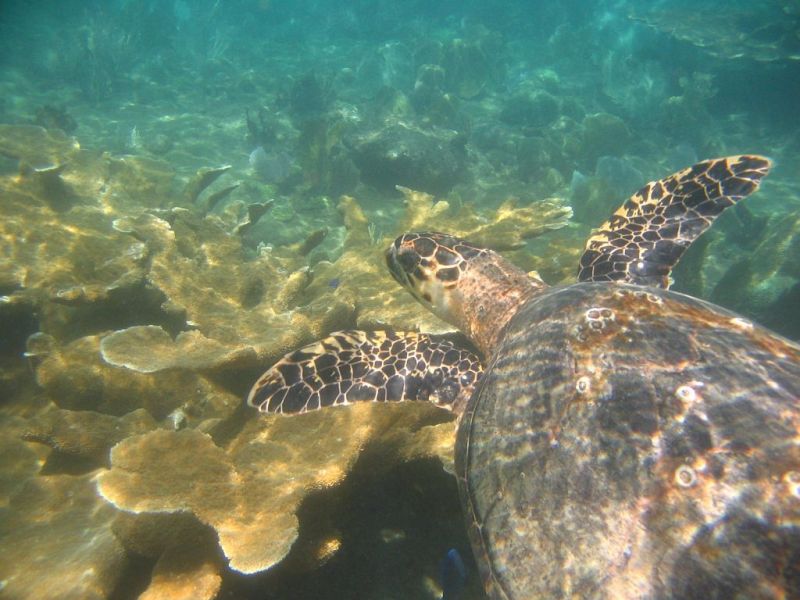Hawksbill Sea Turtles
The hawksbill is one of seven species of sea turtles worldwide and is found in tropical and sub-tropical waters of the Indian, Pacific, and Atlantic Oceans. They occupy coral reefs and various other habitats including rocky areas, lagoons, mangrove estuaries, oceanic islands, and shallow coastal zones. Though hawksbills are distributed widely around the globe, they are critically endangered, with the largest numbers of nesting females found in the Caribbean Sea, perhaps representing 20-30% of the total global population.
Physical Attributes - A Curse?
They get their common name from their tapered head and distinct bird-like beak which enables them to reach into cracks and crevices on coral reefs and other hard to reach areas in search of prey. Adult hawksbills weigh in around 150-200 pounds (45-90 kg) and reach just 2-3 feet (~.5 to 1 meter) in length making them one of the smaller sea turtle species.
Considered to be the most beautiful of sea turtles for their shell, their beauty has led to their severe decline. It’s estimated that in the last 100 years global hawksbill populations have declined by a staggering 90%. Their shell is covered in colorful gold, brown, orange, and reddish streaked overlapping scales (also called scutes) which can be polished and carved to make jewelry, sunglasses, trinkets, and other embellishments. Commonly referred to as tortoiseshell, or ‘bekko' by the Japanese, hawksbill shell has been highly sought after for centuries. Learn more about the turtleshell trade here.

Diet - Picky Eaters
In portions of their geographic range, primarily the Caribbean, their diet as adults is highly specialized, feeding almost exclusively on sponges. Sponges are multi-celled animals that are found attached to the seafloor, coral reefs, rocks, and shells. They have defenses that make them unpalatable to most animals including structural components called spicules, which are tiny glass-like spines that make them difficult to consume, as well as chemical defenses, or toxins, which are found in their tissues. Presumably because of their sponge diet, hawksbill flesh may be harmful to humans and may cause serious illness and in extreme cases even death if consumed.
Ecological Role - Reef Keepers
Only a small handful of marine animals specialize in eating sponges, called spongivory, making the role of the hawksbill on coral reefs an important one. By consuming a diet that consists largely of certain species of sponges, they play an important role in the reef ecosystem by keeping sponge populations in check, which allows other species to occupy space on the reef and increases biodiversity. Without hawksbills, sponges can overgrow and crowd out vital reef-building corals. It’s estimated that one turtle can consume over 1,000 pounds of sponges per year.
Because sea turtles lay their eggs on beaches and mangrove islands, hawksbills are also important for the health of coastal ecosystems. The eggs they deposit in the sand provide nutrients to the beach and surrounding vegetation and are also consumed by natural predators which move nutrients into the system through the passing of fecal material.
Additional Resources:
Photos:
Brad Nahill/SEE Turtles, Neil Ever Osborne, RP Van Dam




